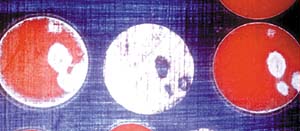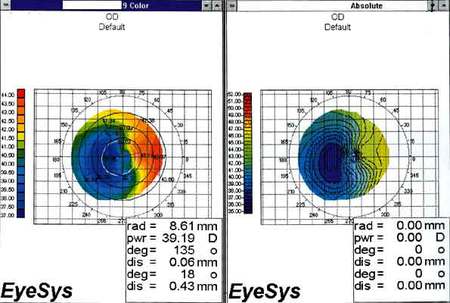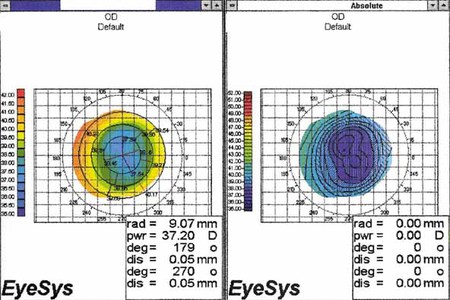LASIK complication corrected with 0.25% sodium hyaluronate
Sprayed solution on mirror caused an irregular island of central tissue.
BOSTON — Islands of corneal tissue caused by a partially blocked mirror in a refractive laser procedure could be cured by coating the bed with sodium hyaluronate and re-treating, according to W. Keith Hamilton, MD.
He suspects that balanced salt solution sprayed onto the mirror of his laser, causing irregularities in the beam profile, caused abnormal stromal beds in nine eyes of five patients.
He has since taken precautions to protect the mirror of his laser. The spraying may have occurred while he was returning the flap or while removing the drape. Regardless of the cause, he had nine eyes to treat in the meantime.
“Having treated a number of patients with this, I was horrified and I didn’t sleep,” Dr. Hamilton said. “I contacted a number of people and spoke with four or five different people across North America to find out what their experience was and what I could do with these patients who, on the first postoperative day, were not very happy.”
One physician Dr. Hamilton contacted said that he had seen 200 patients with this problem. That surgeon’s attempts to treat irregular islands with a scanning spot laser had limited success. About one-third of the patients were happy, “and I didn’t feel that was a very good option,” he said.
PTK used
 ---Photograph showing areas of irregular beam or island.
---Photograph showing areas of irregular beam or island.
Among the nine eyes, preoperative refraction was between –3 D and –8.5 D. All of the patients on the first postoperative day at 1 week and 1 month complained of reduced quality of vision, especially at night with monocular diplopia. Their acuity was uncorrected between 20/30 and 20/100, and the best corrected vision was between 20/15 to 20/40.
Postoperatively, refractions were generally near plano but with considerable cylinder anywhere between –1.25 D and –3 D at or near 180°. The eyes with the most cylinder postoperatively tended to be the people who had the cylinder at 180° preoperatively.
Retinoscopy showed distortion on the bump and that was between the 2-o’clock and the 3-o’clock positions at the edge of the visual axis. It appeared to be right at the edge of the visual axis.
To treat the problem, Dr. Hamilton lifted the flap and painted a thin coat of 0.25% sodium hyaluronate to protect correctly ablated areas while treating the undercorrected peripheral island of tissue.
In some cases, he used a Weck cell sponge to shield the visual axis. He positioned the beam over the affected area, turned the microscope light down, turned the room light out and then did the treatment.
He attempted a 4.5-mm phototherapeutic keratectomy (PTK) to cover the area that was inadequately treated with the first ablation. He estimated a conservative amount of tissue to remove and tried to ablate about 40% of the total central ablation of the first surgery.
“I felt that initially was a very conservative number, and it turned out to be the right number because no one needed an enhancement,” Dr. Hamilton said.
He watched the ablation to ensure that there was no uneven breakthrough, or breakthrough in an area that he did not want to treat.
He did the PTK in three stages, each time trying to obtain about one-third of the anticipated depth.
Prevention as cure
He treated eight eyes with this technique. Postoperatively, three eyes had a normal sphere or cylindrical enhancement, and the subjective clear quality of vision in monocular diplopia was reduced or eliminated in all patients.
“The patients are actually very receptive to this and they were very delighted with the results,” Dr. Hamilton said. Their retinoscopy reflex improved, but was not perfect. All patients had a normal topography.
Intraoperatively, flaps were elevated for between 6 and 8.5 minutes. However, no flap complications or wrinkling developed.
“The main thing with this problem is that you want to prevent it,” Dr. Hamilton said. “I’m absolutely amazed how often this does occur. At this meeting, I’ve heard a number of people speaking about having it occur.”
To protect the laser’s mirror from further spraying, Dr. Hamilton now takes all patients from underneath the laser before removing the drapes. He does not apply any drops to patients under the microscope.
He also advised surgeons to check their PMMA test ablations carefully.
“We checked our PMMA this afternoon when that happened but, unfortunately, I did not check it myself. The technician who checked it thought it looked fine and it looked good in the lensometer, except that there was an irregular spot,” he said.
He also holds the PMMA plate up to a fluorescent light, which offers better visualization.
 |
| Typical pie enhancement topography. |
 |
| Same patient’s topography post-enhancement. |
For Your Information:
- W. Keith Hamilton, MD, can be reached at 750 Spadina Crescent East, #208, Saskatoon, Saskatchewan, S7K 3H3, Canada; (306) 242-9990; fax: (306) 244-1909.
